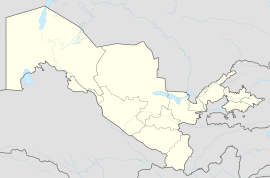
Kyrgyzstan, officially the Kyrgyz Republic, is a landlocked country in eastern Central Asia, lying in the Tian Shan and Pamir mountain ranges. Bishkek is the capital and largest city. Kyrgyzstan is bordered by Kazakhstan to the north, Uzbekistan to the west, Tajikistan to the south, and China to the east and southeast. Ethnic Kyrgyz make up the majority of the country's over 7 million people, followed by significant minorities of Uzbeks and Russians.
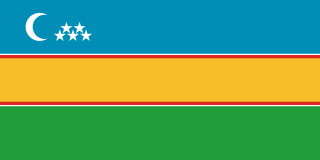
Karakalpakstan, officially the Republic of Karakalpakstan, is an autonomous republic of Uzbekistan. It spans the northwestern portion of Uzbekistan. Its capital is Nukus. Karakalpakstan has an area of 166,590 km2 (64,320 sq mi), and has a population of about 2 million people. Its territory covers the classical land of Khwarazm, which in classical Persian literature was known as Kāt (کات).

This article discusses the administrative-territorial division of the Republic of Uzbekistan. The Article 68 of the constitution of Uzbekistan defines:
The Republic of Uzbekistan shall consist of regions, districts, cities, towns, settlements, kishlaks and auls (villages) in Uzbekistan and the Republic of Karakalpakstan.

Osh Region is a region of Kyrgyzstan. Its capital is Osh, which is not part of the region. It is bounded (clockwise) by Jalal-Abad Region, Naryn Region, China (Xinjiang), Tajikistan, Batken Region, and Uzbekistan. Its total area is 28,934 km2 (11,171 sq mi). The resident population of the region was 1,391,649 as of January 2021. The region has a sizeable Uzbek minority.

Shahrisabz is a district-level city in Qashqadaryo Region in southern Uzbekistan. The Economic Cooperation Organization (ECO) has selected Shakhrisabz as its tourism capital for 2024.

Tashkent Region is a viloyat (region) of Uzbekistan, located in the northeastern part of the country, between the Syr Darya River and the Tien Shan Mountains. It borders Kyrgyzstan, Tajikistan, Sirdaryo Region and Namangan Region, as well as the city of Tashkent which is a region in its own right, forming an enclave entirely encircled by the territory of Tashkent Region. It covers an area of 15,250 km². The population is estimated 2,975,900 (2021). Its capital is the city of Nurafshon. Other cities are Angren, Olmaliq, Ohangaron, Bekabad, Chirchiq, Gʻazalkent, Keles, Parkent, Yangiabad, and Yangiyoʻl.

Qashqadaryo Region is one of the regions of Uzbekistan, located in the south-eastern part of the country in the basin of the river Qashqadaryo and on the western slopes of the Pamir-Alay mountains. It borders with Tajikistan, Turkmenistan, Samarqand Region, Bukhara Region and Surxondaryo Region. It covers an area of 28,570 km2. The population is an estimated 3,408,345 (2022), with 57% living in rural areas. The regional capital is Qarshi.
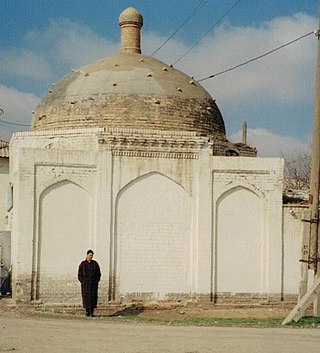
Gʻuzor is a city in Qashqadaryo Region in southern Uzbekistan. It serves as the administrative center of Gʻuzor District. Its population is 24,500 (2016).
Kitab, also transcribed kitaab, is the word for "book" in Arabic, Swahili, and various South Asian and Turkic languages.
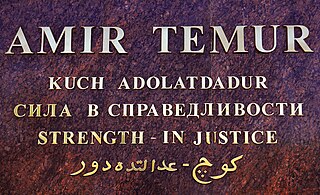
The majority language of Uzbekistan is the Uzbek language. However, many other native languages are spoken in the country. These include several other Turkic languages, Persian and Russian. The official language of government according to current legislation is Uzbek, while the Republic of Karakalpakstan has the right to determine its own official language. Russian and other languages may be used facultatively in certain public institutions, such as notary services and in contact between government institutions and citizens, and the choice of languages in individual life, interethnic communication and education is free. In practice, alongside Uzbek, Russian remains the language most used in public life. There are no language requirements for the citizenship of Uzbekistan.

Burchmullo is an urban-type settlement in the northeast of Tashkent Region, Uzbekistan. It is part of Boʻstonliq District. Its population is 4,100 (2016). It lies by the Koksu River near its inflow into the Charvak Reservoir by the southwestern extremity of the Koksu Ridge, west Tian Shan. It is about 120 km NEE from Tashkent.
The Bible has been fully translated into Uzbek. The full text was made publicly available for the first time September 29, 2011.

Kitob District is a district of Qashqadaryo Region in Uzbekistan. The capital lies at the city Kitob. It has an area of 1,750 km2 (680 sq mi) and its population is 266,400. The district consists of one city (Kitob), 13 urban-type settlements and 12 rural communities.
Chiroqchi is a city in Qashqadaryo Region, Uzbekistan. It is the capital of Chiroqchi District. Its population is 23,800 (2016).

The Museum of Geology in Tashkent, Uzbekistan is a geology museum that shows and represents the wealth of mineral and geological resources in Uzbekistan, including valuable stones, minerals and archaeological and paleontological findings.
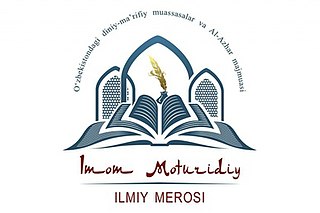
The 2020 International Maturidi Conference was an international scientific-practical conference held over three days, from 3 to 5 March 2020, in the city of Samarkand and under the title of "Imam Abu Mansur Maturidi and the Teachings of Maturidiyya: The Past and the Present".
Ahmadjon Odilov was an Uzbek politician. For his work in agriculture management, he was awarded the title Hero of Socialist Labor. In his political career, he was a member of the Central Auditing Commission of the Communist Party of the Soviet Union (CPSU) between 1966 and 1971. He was a delegate to the XXIII, XXIV and XXV Congresses of CPSU, and a deputy of the Supreme Soviet of the USSR of the 9th and 10th convocations (1974–1984). He was also a member of the Presidium of the Supreme Soviet of the USSR and was elected to the Supreme Soviet of the Uzbek SSR three times.

Kitab State Geological Reserve is located in the Kitab district of Kashkadarya region, Uzbekistan. It is located on the south-western branches of the Zarafshan mountain range, on the left bank of the Jinni Darya and on the northern side of Karatog, 45 km east of the city of Kitab. The area is 5378 ha. It was established in 1979 in order to study and protect unique paleontological-stratigraphic objects, which are natural-scientific monuments related to the geological history of the Earth. In the Kitab State Geological Reserve, marine sediment formations from the Middle Ordovician period to the boundary layers of the Devonian and Carboniferous periods are observed in a stable consistency in several stream valleys that cross the direction of the rocks of the Paleozoic layer. They are characterized by various paleontological phyla representing fauna and flora belonging to 16 different groups.
Mausoleum of Hazrat Sultan is a memorial site located in the Shut village of the Koʻhsor neighborhood in the Kitob district of Qashqadaryo region, dating back to the 12th to 13th centuries. According to the rights of non-residential property, it is considered state property, operated under the jurisdiction of the cultural heritage department of the Qashqadaryo region. It is designated as a state-owned property in accordance with the agreement for the use of the "Vaqf" charitable community fund.

